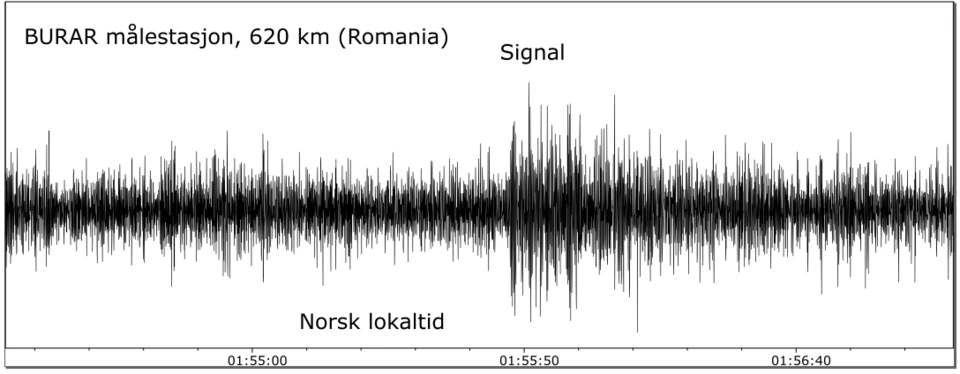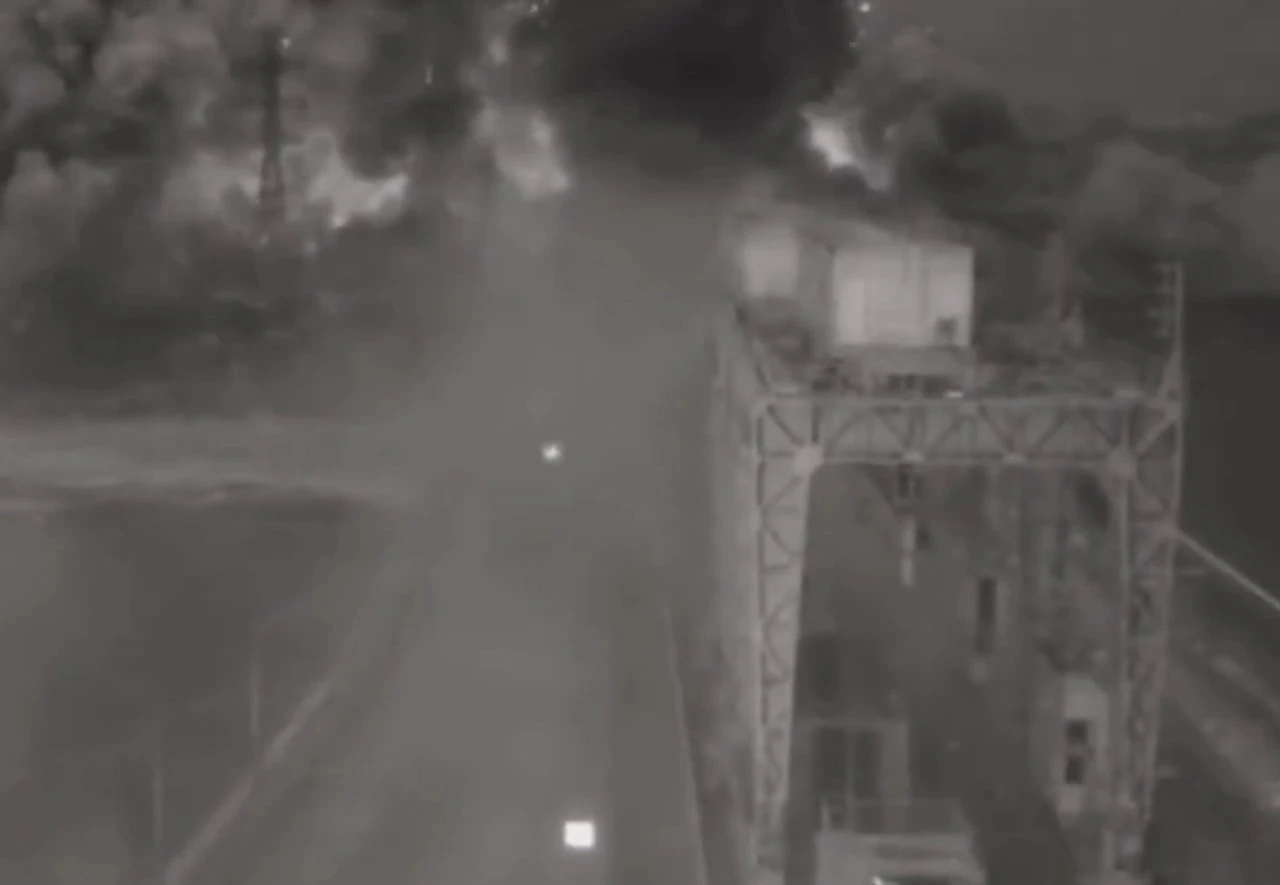On Tuesday night, Seismic stations in Ukraine and Romania detected what appears to be an explosion at the Kakhovka Dam on the morning that it collapsed. This is according to the data, analyzed and published on June 7th by NORSAR.
Is fresh NORSAR data on Kakhovka Dam the evidence of the explosion?
NORSAR is known as the Seismic Array, founded in 1968 for the detection of earthquakes and nuclear explosions. This Norwegian group monitors seismic networks throughout Europe. They have received and analyzed seismic signals from regional stations in connection with the dam collapse in Ukraine.
The report says that seismic data from regional stations show clear signals on Tuesday, 6 June, at 2:54 Kyiv time in coordinates: 46.7776, and 33.37, coinciding with media reports on the Kakhovka dam’s collapse. The chart below shows signals from the Bukovina (BURAR) seismic array - station situated at 620 km distance from the Nova Kakhovka.

This detection is the first element of independent evidence that the dam, which held back a reservoir roughly the size of Utah’s Great Salt Lake, was blown up rather than collapsing from strain and inaction.
In a commentary to NPR, Volker Oye, a NORSAR seismologist who has analyzed the data, said: “We see a pulse of energy which is focused, which is typical of an explosion,” NPR. Oye added that explosions in this region of Ukraine are rarely seen, so a blast due to something else would be an unusual coincidence.
Does this deny latest the version by CIT that dam was destructed just due to Russia’s criminal inaction to Ukraine’s damaged critical infrastructure object? While signals indicate some kind of explosion, the seismic arrays can’t clearly locate the blast closer than within 20-30 kilometers (12-19 miles) of the dam. To clear that out, I’ve asked the organization that provided a seismic forensic report on the Beirut explosion on August 4, 2020- European Geosciences Union for their comment. At the moment of publishing the article, I’ve not yet received any notes from them. I’ve I will the article will be updated.
Nova Kakhovka Dam destruction - version by Conflict Intelligence Team
Previous CIT analysis of the accumulated evidence suggests that a deliberate explosion did not cause the dam collapse, Russia is entirely responsible for the incident, as they were obligated to ensure the security of the infrastructure in the occupied territory. The accident can be attributed to either criminal inaction or the blowing up of the highway during the Russian forces' withdrawal from the right bank of Dnipro in November.

According to the report by CIT, before possible explosions were reported by NORSAR, on the night of June 5-6, the dam’s destruction resulted from the Russian forces' criminal negligence. This conclusion was reached by comparing satellite images from various sources, including Sentinel, Planet, and Maxar, taken between November 2022 and June 2023.
Russian withdrawal in November
In the November 10 photo, Russian forces were still present on the right bank of the Dnieper River, controlling the hydroelectric power station. Two gantry cranes were observed at different locations on the dam, closer to the left bank, with water discharge visible under one of them.
On November 11, the Russian military officially left the right bank, and a powerful explosion occurred at the Kakhovskaya hydroelectric power station, destroying the road over the dam closer to the right bank. Gantry cranes were then relocated to the engine room near the right bank, positioned close to each other, and there was no water flow visible.
By November 15, the cranes remained near the turbine hall but at a distance from each other, and water began to flow underneath them. Subsequent photographs until June 5 showed the cranes in the same positions, with water discharge continuing. This led to the conclusion that Russian forces had not regulated the water level in the reservoir since November 15.
In the May 28 photo, the cranes remained in the same position, with ongoing water discharge, and minor damage was observed on the road branch since November, likely due to shelling by the Ukrainian Armed Forces.
The photos from May 31 and June 2 showed consistent conditions, with the section of the road above the open gates collapsing and widening into a more significant failure by June 4.
Did the Nova Kakhovka dam collapse by itself?
The June 5 photo provided detailed evidence of the collapsed section of the road. All these findings support the theory that the dam damage occurred gradually. However, can the destruction of a few sections of the road be caused by some kind of human intervention? We don’t know that yet.
Besides satellite images, other data only indirectly support this theory. A graph of the water level in the Kakhovka reservoir, based on satellite data, showed significant fluctuations from fall 2022, including a sharp decrease to an abnormally low level at the beginning of the year and a subsequent sharp increase to a record high by June 2023 due to spring floods and rains. It is important to note that the week preceding the destruction was rainy.
Concerns regarding the situation were previously highlighted in several publications. In February 2023, US National Public Radio (NPR) reported that Russia was draining the Kakhovka Reservoir, endangering the safety of the ZNPP and water supply to settlements and agricultural enterprises. The water level had reached a three-decade low. The Zaporozhye OVA also warned of potential water shortages in Energodar, Melitopol, and Berdyansk due to the reservoir drainage. However, the Russian authorities controlling these cities ignored the issue.
In April, Roman Tkachuk, head of the civil protection department of the Kyiv administration, stated that the Kakhovka hydroelectric power station was not operating at full technological capacity. This hindered maintaining the water level in the Dnieper River, and, combined with snowmelt and heavy rains, resulted in flooding in Kyiv.
On May 4, Vladimir Rogov, chairman of the movement “We are together with Russia,” revealed that a dam failure near Kamenka-Dneprovskaya, caused by a record-high water level in the Kakhovka reservoir, could potentially flood thousands of households in the Zaporizhzhia region. He attributed this partly to persistent rainfall and the complications in water discharge from the reservoir downstream of the Dnieper due to damage at the Kakhovskaya hydroelectric power station
A fact that the dam obviously was in poor condition, but did just this or the human-crafted explosion cause this cataclysm that by the Geneva Convention may be considered as an equivalent of using weapons of mass destruction?
If that’s an explosion: did the Ukraine blow up the dam?
As the collection of evidence is still in process - let’s figure out the impact for both sides to at least understand the motives for both sides if they take place.
Impact of Kakhovka Dam destruction on Russia and Ukraine
The main allegation is that ”by blowing up the dam, Ukraine wiped out the first line of Russian defense under Kherson before its counteroffensive.” But did this really bring any benefits to Ukraine’s armed forces?
Military impact
First, suppose we assume that Kherson was one of the possible directions for AFU’s summer deliberation campaign. In that case, now, it’s delayed at least for a few months until the water drains, the soil will dry out, and become passable for heavy military equipment. Does it somehow benefit Russia?
Despite wiping out russian defensive mining fields, the current situation narrows the focus of the Russian defense campaign. From the list of Ukraine’s four projected directions of counteroffensive (Bakhmut-Donetsk, Zaporizhzhia-Melitopol, Kherson-Crimea, Kharkiv-Luhansk), Russia now can cross out one, leaving them with more military personnel, and equipment per possible direction.
Social and economic impact
Second, let’s assume that Russia couldn’t blow the dam because it left Crimea without water. While this is partially true, according to russian media reports on July 2021 - The flood gave Crimean reservoirs drinking water for two years, and all reservoirs of Crimea were filled. Additionally, due to russian media reports - on July 30, the first batch of water for the peninsula was produced from wells under the Sea of Azov. So is the water problem in Crimea even real?
At the same time, it is hard even to project countless negative effects for Ukraine and Ukrainians from destroying the Nova Kakhvovka dam. Here is just a brief list of what Ukraine faces because of this disaster:
The flood affected at least 30 settlements and necessitated the relocation of about 20,000 people. The evacuation efforts for the right bank only drained the precious: 1,850 people and more than 345 units of equipment involved in the liquidation of the consequences of the Kakhovska Dam terrorist act. In particular, there are 810 rescuers of Ukraine’s State of Emergency Service and 226 units of the Service’s equipment, including 42 watercraft.
About 15 billion cubic meters of water will cover the agricultural land in the lower reaches of the Dnipro in the upcoming days. It is mostly occupied land on the Kherson region’s left bank, but it affects the right bank, which was liberated in November of 2022. Ministry of Agrarian Policy of Ukraine notes:
“In total, we are talking about the flooding of more than 70,000 hectares of plantations and fields — because the terrorist attack destroyed the largest water reservoir in Europe.”
As for now, the consequences are still counting, as the water has not yet drained.
Ecological impact
Apart from economic and social disasters, the dam destruction is a pure act of ecocide, leading to: Mass death of aquatic organisms (fish, mollusks, crustaceans, microorganisms, aquatic vegetation) with further disturbance of their habitat, including birds and other amphibians and animals;
-
Significant risks for rodent populations, in particular, endemic species and those listed in the Red Book of Ukraine;
-
Disturbance of the habitats of plant complexes;
-
The pollution of the waters of the Dnipro and the Black Sea - primary pollution due to the ingress of fuel and lubricant materials into the waters, washing away of garbage, agrochemicals, and other dangerous materials, flooding, and failure of sewage treatment systems, sewage, and so-called “secondary pollution”;
-
Leaching, transfer of mines and other explosive substances, increase in mine danger for years to come;
-
Negative impact on water areas, coastal areas, and the land part of three Ukrainian national nature parks - “Nizhnyodniprovskyi”, “Kamyanska Sichi”, “Biloberezhya Svyatoslav”, Black Sea Biosphere Reserve (this territory also has the status of a UNESCO biosphere reserve), Regional landscape park “Kinburnska Kosa” and numerous objects of the nature reserve fund with smaller areas.
All these territories also have the status of Wetlands of international importance, protected in accordance with the Ramsar Convention, and are also territories of the Emerald Network, protected in accordance with the Berne Convention; Nuclear threat Apart from this, collecting water necessary for cooling the Zaporizhzhya NPP - the biggest nuclear power plant in Europe, with six operational nuclear reactors is now impossible. This outcomes in a threat to the nuclear safety of the world, situated on Ukrainian soil and artificially created by Russia.
So who has the real motive? Ukraine, taking the unprecedented damage due to the Nova Kakhovka dam destruction? Or Russia, which spend all 2022-2023 winter trying to destroy Ukrainian critical infrastructure with countless missile and drones attacks to force Ukraine into the negotiation table?




